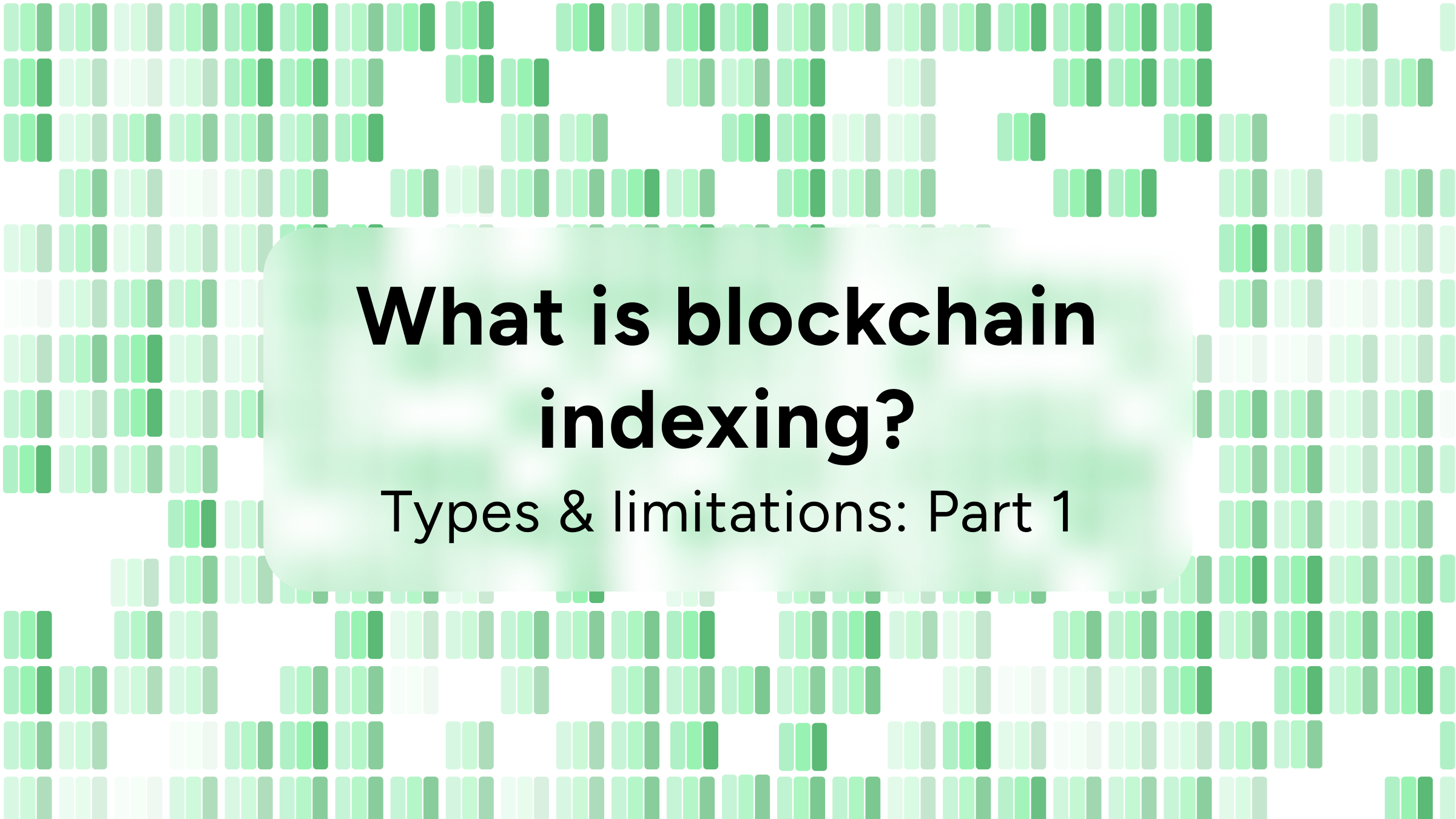What is blockchain indexing? Types, limitations and tools.
Indexing makes blockchain data usable. This guide explains why indexing is essential for dApps, wallets, bots, and dashboards and how Ormi delivers real-time performance at scale for modern chains.

Blockchain indexing is one of the most critical, but least understood parts of the Web3 stack.
It’s what makes decentralized apps usable, dashboards responsive, and trading bots functional. Without indexing, even basic queries like “fetch all transactions made by this wallet" becomes difficult and inefficient.
Yet most builders don’t see indexers as core infrastructure. This oversight creates significant scalability and usability challenges as blockchain adoption increases. To understand why indexing is so important, we have to delve into the basics (don’t worry, we’ll make this easy).
What is blockchain indexing?
Indexing is the process of making blockchain data accessible, searchable, usable, and easily analyzed.
Blockchain nodes store data in raw blocks, which is a good format for storing in a ledger, but terrible for searching data. Nodes are designed for efficient writing, not reading. Nodes may have basic indexes that allow fetching a transaction by its hash, but they lack the sophisticated databases required to query data based on the content. And their data is encoded to reduce storage space. By default, it’s not human-readable, so if you want to find every transaction on a DEX, made in the past 30 days, for example, you need indexed data. You can't do that efficiently by reading the raw data from a node.
Indexers process raw block data, organize it into structured formats, and make it available through a queryable interface.
Why indexing is important for blockchain applications
Most people don’t interact with blockchains. They interact with applications. And applications rely on indexed data.
Without indexing:
- Wallets can’t show balances or token histories
- Dashboards show stale data
- Trading bots lose money
- UIs can’t react to contract events in real time
Blockchains are designed for data integrity and consensus, and not for efficient querying. They're optimized for writing data (like OLTP databases), not reading or aggregation.
Think of indexing as the OLAP layer for blockchain data. The blockchain writes the truth. The indexer helps applications read it efficiently.
This is why most dApps rely on separate infrastructure: indexers, subgraphs, or APIs to stage and serve data in formats suitable for UI rendering, analytics, or programmatic automation.
If you’re building anything that uses blockchain data, indexing is not optional. It’s essential.
The various types of indexing strategies
Blockchain nodes contain a lot of data. The scope of data indexed is driven by how it will be used. If we need to power a dApp, for example, a Graph DSL strategy should be plenty, but if we need to support a historical analytics engine, we’re going to need all the data!
These strategies vary in complexity and data completeness, depending on the use case:
| Strategy | Function | Purpose |
|---|---|---|
| Event-based indexing (logs only) | Indexes emitted logs/events from smart contracts. | Good for notifications, automations, and rebalancing in DeFi. |
| State-based indexing | Processes logs + calldata to mirror on-chain data. | An accurate off-chain mirror of contract state. |
| Block-level / trace based indexing | Indexes full blocks, traces, calldata, and state. | Full visibility. |
| Graph DSL (subgraph-based indexing) | Declarative schema & handlers for logs and calls. | Just enough to power dApps. |
| ETL-based indexing (batch & historical) | Batch processes of raw data. | Full visibility into current and historical state. Ideal for analytics. |
Accessing indexed data
Indexing is the technology used to fetch, organize and store the data. Most developers only interact with the endpoints like APIs, SQL and subgraphs which are defined by its function below.
| Type | Description | Function | Limitation | Examples |
|---|---|---|---|---|
| Subgraphs | Custom schemas + event handlers for smart contracts. | Flexible, smart, contract-native, real-time capable. | Dependent on RPC node quality & indexer setup. | • 0xgraph by Ormi Labs • The Graph • Goldsky |
| Data API | Pre-built endpoints (for example, /wallets, /transfers). |
Easy to use, fast to integrate. | Less flexible. Limited logic. | • 0xAPI by Ormi Labs • Moralis • Alchemy |
| SQL | SQL dashboards over indexed data. | Great for analysis | Not built for real-time dApps. | • Dune • Flipside • Allium • Space & Time |
| Hybrid architecture | Combine APIs + subgraphs | Use cases that require both account-level and protocol-level data. | Implementation dependent | — |
Each of these has different performance characteristics depending on:
- Query load
- TPS of the chain
- Real-time vs batch needs
- Data freshness requirements
Limitations in various indexed outputs
Every indexing strategy has tradeoffs:
| Tradeoff | Capabilities |
|---|---|
| Real-time data vs Data completeness | Some indexers prioritize speed, others prioritize depth/history. |
| Customizability vs deployment speed | Subgraphs give you control; APIs get you started faster. |
| Scalability vs simplicity | Real-time indexers need next-gen indexer infrastructure to support fast chains. |
| Data consistency vs latency | Indexers must be fast and resilient to chain re-organizations (re-orgs). Handling re-orgs correctly is computationally expensive and is a key differentiator for production-grade indexers. |
The main challenge for providers is balancing these tradeoffs while meeting the needs of demanding applications as more people start using blockchain.
Where Ormi fits in
Ormi focuses on real-time indexing that scales with modern chains. From day one, Ormi has been developing the next-generation indexer.
- Sub-second latency at sub-30ms at 1,000+ RPS
- Supports high load chains transacting 250+ TPS
- Designed to work with modular execution, L2s, and fast-finality environments
- Offers both subgraph-based and composable API access
- Automatic re-org built-in
Ormi’s approach blends customizability with real-time performance, making it well-suited for:
- Financial transactions and real-time settlements.
- Protocol frontends and dashboards
- Trading bots and AI agents
- Ecosystem data feeds and real-time chain-wide observability
Understanding the indexing landscape
Blockchain indexing isn’t a one-size-fits-all solution. Understanding the types of indexing available from data needs to dev-facing tools is key to building performant apps.
This guide focused on the foundational types and tradeoffs. In Part 2, we’ll cover how to choose the right indexer based on your application’s needs. In Part 3, we’ll feature the leading providers.
If you’re building on fast chains, working with real-time data, or want your app to be performant then Ormi is built for you.
About Ormi
Ormi is the next-generation data layer for Web3, purpose-built for real-time, high-throughput applications like DeFi, gaming, wallets, and on-chain infrastructure. Its hybrid architecture ensures sub-30ms latency and up to 4,000 RPS for live subgraph indexing, sub-10ms responses across 100+ API schemas, and a powerful SQL engine for historical and AI-ready data.
With 99.9% uptime and deployments across ecosystems representing $50B+ in TVL and $100B+ in annual transaction volume, Ormi is trusted to power the most demanding production environments without throttling or delay.






